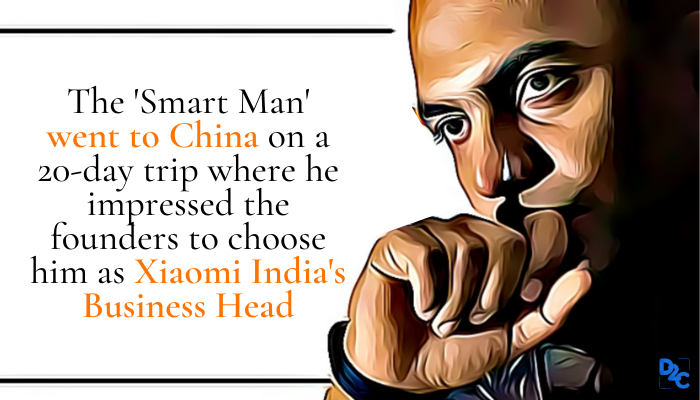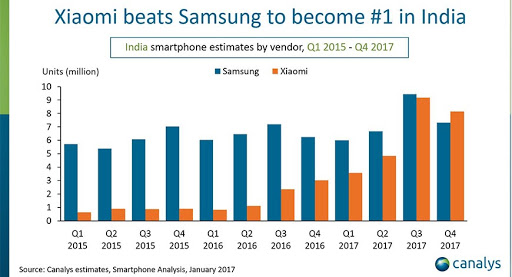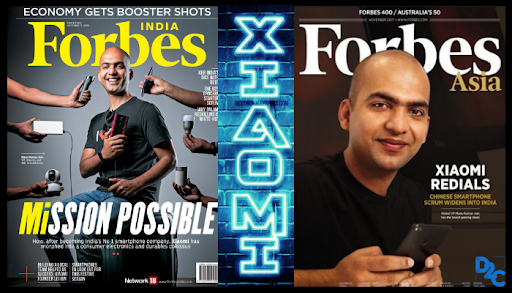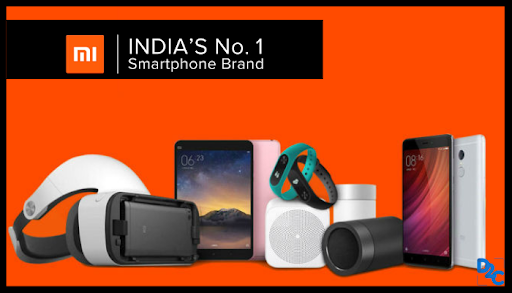Meet the 'Smart Man' behind Xiaomi Smartphone - Manu Kumar Jain

When we think of smartphones, Xiaomi is definitely a name that instantly pops up in our minds. The leading Chinese brand, also known as the “Apple” of China entered India to launch its first smartphone in the year 2014 and within 3 years of its presence in the country, Xiaomi held the crown of number 1 mobile player in the Indian market despite tough competition from Samsung, Vivo, Oppo, and Realme.
Xiaomi’s Global Vice President, and Managing Director, Mi India, Manu Kumar Jain had disclosed that the company had shipped a record 9.2 million smartphones in the third quarter of 2017 in India. This was for the first time since Xiaomi first entered India back in 2014 that the company was hitting such a monumental stride in phone shipments.

It was not just in 2017 that Xiaomi took the Indian smartphone market by storm but it has been pretty much consistent in keeping its graphs up. The nation had a rough start of 2020 as smartphone shipments stagnated with the start of the COVID-19 pandemic. However, it improved in the second half of the year with a record high Q3.
Q2 2020 saw the biggest decline, dropping more than 40% YoY compared to Q2 2019. The market was able to recover in Q3 and Q4 saw 13% growth, with 43.9 million units.
Xiaomi (including POCO) accounted for the most smartphone market share in Q4, consisting of 27% with 12 million units followed by other major smartphone brands as shown below-
|
Xiaomi |
12 million units |
27% market share |
|
Samsung |
9.2 million units |
21% market share |
|
Vivo |
7.7 million units |
18% market share |
|
Oppo |
5.5 million units |
13% market share |
|
Realme |
5.1 million units |
11% market share |
The “Clueless Entrepreneur”

In 2011, when the IIT Delhi and IIM Calcutta alumnus, Manu, took a break from being a consultant at McKinsey, he was a “clueless entrepreneur".
At that time online shopping in India was very small and Jain decided to join Jabong as one of its co-founder in 2012. “I had never realized the power of e-commerce till now," he says. It was a major change for Jain, because all his work at McKinsey was tailored for brick-and-mortar clients. Jabong had a very humble beginning. There would be days when Jain and his partner Sinha would pray for 100 transactions, but quickly, they touched 1,000 transactions daily. He says they achieved big numbers “way before we expected it".
Jain believes there were two reasons online shopping became so big in India.
- For metros and bigger cities, e-commerce offered an escape from traffic and parking issues.
- For smaller towns, convenience and availability were big factors. “Will someone find the latest Nike shoe in a smaller town?"
Kick Starting the journey with Xiaomi

It was not until his trip to China in 2013—where he met Xiaomi’s top brass—that Jain decided to leave Jabong, although he still retains a very small equity share in the company.
Manu Kumar had come across Xiaomi’s business model, while researching smartphones. Though he had never heard of the company, their ideas around “online-only” sales seemed fascinating. So fascinated he was, that he went backpacking to China, and ensured that he fixed a meeting with Bin Lin, the co-founder and president of Xiaomi. A few months later, they got in touch. The company was planning to enter the Indian market and were looking for an India business head and needless to say, they believed in Manu’s skills.
Manu had lacked the domain expertise in selling phones, but he finally took the decision to join Xiaomi in April 2014 and joined in May. Manu then had no team, no office, just him working out of a Costa Coffee next to Flipkart headquarters in Bangalore. He just had the mindset of the Operations Head, India.
Taking the Indian Market by storm!
Manu’s plans and strategies made a huge impact in the Indian tech market on the release of its first smartphone in 2014. More than half a million customers attempted to log in and buy the phone. For the first time in its history, the Flipkart site crashed. Crazy, isn’t it?
The sale was so huge that Xiaomi quickly announced a second sale in the same month and this time Flipkart had to build a new tech platform – in just one week – to handle the traffic that was sure to come its way.
Decoding Xaiomi’s success factors

The massive success of Xiaomi has a lot to do with great products that as aforementioned are affordable, have an empowered local team and an amazing home market strategy within India, and an amazing leader like Manu.
Talking about Xiaomi's major success factors in India like the price point, the distribution channel, and fan-based community, Manu explains that, “the first one is definitely the product. If the product is not great, we cannot succeed no matter what we do. Every time we launch a product, it needs to have the latest and the best specs of innovation, the highest possible quality standards, and it has to come with an honest price. It may not be the lowest price, but we keep a less than five percent profit margin for ourselves. We cut down on the cost and then pass it on to users, and that’s why we call this 'honest price'. If you look at many of the historic brands, they were great at innovation and great at quality, but extremely bad on pricing. I believe today we are the only brand across different product categories that can take the box on all three: product, quality, and price. If you don’t have a great product with great quality and pricing, you cannot win.”
According to Manu, the second thing that makes Xiaomi different from others is their people, “It is the place you know the majority of people do not come from a smartphone background. They come from an internet background. They’re from companies like Google, Facebook, eBay, Flipkart, Snapdeal, etc. For many people, they have never done anything like this before; they are willing to take risks.”
Other factors contributing to its success:
- Less is More: Lei Jun put the concept of ‘The Beauty of Simplicity’ into the company’s smartphone products. Xiaomi has launched only one or two models a year to concentrate on achieving the best quality of its products. This gap between different product developments has resulted in the best output.
- Ultimate: ‘Ultimate’ means doing something that you are best at and reaching perfection that others have never attained. Even when Xiaomi products have already been in the market for about half a year or more, it is still hard to find other cellphones with the same, or better, specifications.
- Fast Speed: Xiaomi’s speed can be described as ‘fast response, fast replacement and fast correction.’ They deploy a beta version, collect user opinions and modify the model to reflect the feedback.
- Word of Mouth: The word of Mifen, Xiaomi’s fan club, has gone around the world and has been translated into more than 20 languages. Xiaomi provides a user experience that satisfies consumers by surpassing their expectations.
The onset of the Online Market
One of the most important reasons for their massive success is that they haven’t done anything similar to what other companies did. In 2014, 94 percent of the market was offline. Only six percent were online.
When they were launching, Manu went to a large number of tech CEOs, mentors, and people who had run mobile companies before. According to most of them, this strategy was erroneous, they said, “Manu, this is the wrong strategy. You are going after the six percent market. Ninety-four percent of the market is offline. The way to sell a smartphone is by spending a lot of money on marketing and selling offline. You are doing none of it”.
These suggestions did trigger stress among the team, they thought they were doing something wrong but as Manu puts it, “we have never done what others did.” So at a time when the market was going offline, they went online. And that proved to be a great decision.
“We now have close to 50 percent market share within the online segment. We grew that. We have done a lot of things differently, but it is our channel, whether it is distribution, or it is marketing using social media, and that has helped us to differentiate from any other brand that has been traditionally here in India.”
According to Manu, E-commerce has allowed them to make these handsets, “a lot more affordable, as compared to brick-and-mortar stores and selling through physical stores is completely out of the question.”
What did Xiaomi do that other foreign brands didn't?
Numerous foreign brands are trying to make inroads into the Indian market, and what many do not realise is that India is not one country. Manu while explaining the pitfalls that a foreign brand faces in India says, “India is a combination of 30 countries in a way because we have 30 provinces or states. Every state, every province has a different core, language, religions, and food.”
When you’re building products or a business, you have to keep in mind that it’s almost like building a business for different countries with different and diverse cultures and backgrounds.
“You have to keep that in mind; you cannot build it the way you would build it for the US or even for China, because it’s (India) not an homogeneous country. When we started building phones, from day one we had it always available in 12 different languages. Now we cover almost all key Indian languages. People will want to consume content in their local, native language.” Adds Manu.
Zero Cost Marketing
By now it's established that Xiaomi has gained massive success, but the question is, what made this Chinese brand anchor itself as the best in the Indian market in such a short duration despite its claims of 'zero cost marketing'?
The phenomenal success of Xiaomi, as dissected by Manu Kumar Jain, has a lot to do with great products that come at an honest price, the home market strategy in India, and an empowered local team. Manu, who started as a “clueless entrepreneur” with his charisma and entrepreneurial spirit, was the man who had a major role in pulling all this together.
Xiaomi’s marketing strategies
Xiaomi India has been vocal about its innovative marketing strategies on social media and how they are a trendsetter. The company’s executives along with Manu Kumar Jain, often boast about how Xiaomi became a leading smartphone brand in India with “zero cost marketing”. In a recent post on LinkedIn, while promoting the upcoming Mi 11 Lite smartphone, Manu Jain shared how Xiaomi’s marketing innovation and not marketing costs make all the difference for the company.
While the post garnered a lot of praise on the professional social media platform, people were quick to point out that how come Xiaomi’s marketing cost and budget be “zero” when ads of Xiaomi’s phones are visible all over the social media, YouTube, newspapers, TV and other platforms. In fact, in 2017, Xiaomi even announced bollywood actress, Katrina Kaif, as an endorser for its new Redmi Y series in India and Ranveer Singh in 2019 endorsed the Redmi Note 7 series smartphones.
Considering all these factors, a user on LinkedIn finally wrote, “Manu Kumar Jain come on now. I am not able to watch a single video peacefully at YouTube just because of repeated ads of Mi 11 lite.” To this, Manu's gentle reply left the audience in awe.

Needless to say, this massive success that Xiaomi tasted in such a short duration was majorly possible because of Manu Kumar Jain----once a “clueless entrepreneur” who found his way to become one of the most valuable members of Xiaomi, which is currently the largest smartphone manufacturer in China and the fifth-largest in the world.
For more such interesting articles, read -
- Kamal’s blooming journey from a village to Barista at Starbucks to XLRI
- UNCCD opens internship doors for graduates - Apply here
- Snapdeal 2.0- Scripting the business turnaround of an e-commerce
- IIMs and IITs see an upsurge in placement packages during COVID-19
- How Mondelez made Cadbury pour like a melting lava in our hearts?
Login to continue reading
And access exclusive content, personalized recommendations, and career-boosting opportunities.
Blogs you need to hog!

What Innovation Does For Efficiency and Competitiveness in a Corporate Sector?

Online to Offline Commerce- Everything one needs to know

How Do You Work Around Branding Guidelines To Be Guidelines And Not Limitations? | Alekhya, Brand Manager- Vivel, ITC | Dove, Unilever













Comments
Add comment